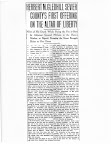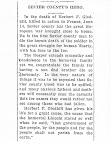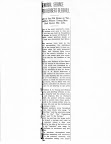
Thomas and Lille Belle Gledhill had a son Herbert, born September 21, 1890, and like his brothers before him (5) and his many other cousins, he was born, raised, and schooled in Vermillion or Sigurd. On December 20, 1911 Herbert married his childhood sweetheart, Maggie Short McMillan, in the
Manti Temple. Herbert was 21 and his bride was 17. Maggie was the daughter of John and Mary McMillan, also residents of Sigurd. The newlyweds built a small home on the McMillan property and settled in for what they hoped would be a long and happy life. However that was not to be the case.
On the 24th of Nov 1912 the couple were blessed with their first child and named him Max Herbert Gledhill. But Max only lived a year a few months and died on Feb 6, 1914 of pneumonia and pleurisy and was buried in the Sigurd cemetery. Two years later on August 15, 1916 a second child, again a boy, was born. They named him Millan after his maternal grandfather.
But all was not well. Maggie only lived a few months after the birth of Millan. She died in Salt Lake City on January 11, 1917. Her death certificate indicates a cause of death as Nephrites, a condition she had suffered for two years according to the record. She was brought home and buried next to her son Max in the Sigurd cemetery. The newspaper account of her death is poignant in describing the family tragedy and the overwhelming grief.
This left young Herbert, 27, a widower with a 5 month old son to care for. He had lost both a wife and a child within three years. On June 5
th, 1917, Herbert Gledhill registered for the draft, listing a dependent child and claiming no reason for exemption. He even listed marital status as married rather that widowed. He did not seek any exemption for service based on hardship.
Herbert seemed driven to enlist in the army and fight for his country in the Great War in Europe. There may possibly have been more than that driving him. A report in the local newspaper indicated his mother prevailed on him to wait for a few months for his young son’s sake. He did so, but when the call came, he went to Camp Lewis and was assigned to the 26th infantry, Company M, and sent to the trenches of Europe. He fought in Flanders and Piccadilly and spent a total of seven months fighting the Huns in those awful trenches of France. In a letter home he described the nights "like a great lightning storm at Fish lake, only 100 times worse". He died in battle on June 14th, 1918. The Richfield Reaper reported his death as heroic and noble and the “First Offering of Sevier County on the Altar of Freedom.” His body was returned to the land of his birth with great ceremony and he was buried a hero along side his sweetheart in the Sigurd cemetery.

But what happens to the two year old Millan who is now known as Sevier County’s first “War Orphan?” He continued to live and be raised by his maternal grandparents (the McMillan’s) in Sigurd. However, his grandfather McMillan dies in 1921, leaving his wife a widow with a daughter Mary age 17, as well as Millan age 5. His son John had previously married at age 17.
So Millan was primarily raised by his grandmother in Sigurd, probably assisted by his Gledhill grandparents, until he marries Leone Peterson of Central. They are both 19 years of age. I don't know much of Millan's life after that other than he was sealed to Leone in the Manti Temple in 1953 and lived a good life and died in 2001 at age 85. Leone lived another 5 years and died in 2006. they are buried together also in the Sigurd cemetery next to the parents that he hardly knew.

But let's wrap up a few loose ends in this story of love, tragedy, and patriotic duty. Millan's grandfather, John McMillan, was a cattleman. His son John McMillan Jr. likewise ran cattle and owned the property at the base of Booby Hole Mountain in Grass Valley. We knew him as "John Mac". His wife Lucille was his perfect complement. Mary Hummel was a daughter of John and Lucille's and grew up with the Anderson girls in Sigurd. She later taught school and wrote and delivered special poems at both Leda's and Floyd' s funerals. The families were very close friends. And Millan himself also spoke at Floyd's funeral.
As you can see, these are relationships that extend not just for a few years, but rather for generations, and then on into eternity. They become part of a great tapestry of life that has a pattern only discernible when seen at a distance. There is such human emotion woven throughout it all. .. and that's what gives it such beauty.
.
Check out the Reaper articles, they are well worth the read!!!

- Body Returned from Europe



The End


 But let's wrap up a few loose ends in this story of love, tragedy, and patriotic duty. Millan's grandfather, John McMillan, was a cattleman. His son John McMillan Jr. likewise ran cattle and owned the property at the base of Booby Hole Mountain in Grass Valley. We knew him as "John Mac". His wife Lucille was his perfect complement. Mary Hummel was a daughter of John and Lucille's and grew up with the Anderson girls in Sigurd. She later taught school and wrote and delivered special poems at both Leda's and Floyd' s funerals. The families were very close friends. And Millan himself also spoke at Floyd's funeral.
But let's wrap up a few loose ends in this story of love, tragedy, and patriotic duty. Millan's grandfather, John McMillan, was a cattleman. His son John McMillan Jr. likewise ran cattle and owned the property at the base of Booby Hole Mountain in Grass Valley. We knew him as "John Mac". His wife Lucille was his perfect complement. Mary Hummel was a daughter of John and Lucille's and grew up with the Anderson girls in Sigurd. She later taught school and wrote and delivered special poems at both Leda's and Floyd' s funerals. The families were very close friends. And Millan himself also spoke at Floyd's funeral.






